sensor FIAT DUCATO BASE CAMPER 2015 Owner handbook (in English)
[x] Cancel search | Manufacturer: FIAT, Model Year: 2015, Model line: DUCATO BASE CAMPER, Model: FIAT DUCATO BASE CAMPER 2015Pages: 367, PDF Size: 19.73 MB
Page 128 of 367
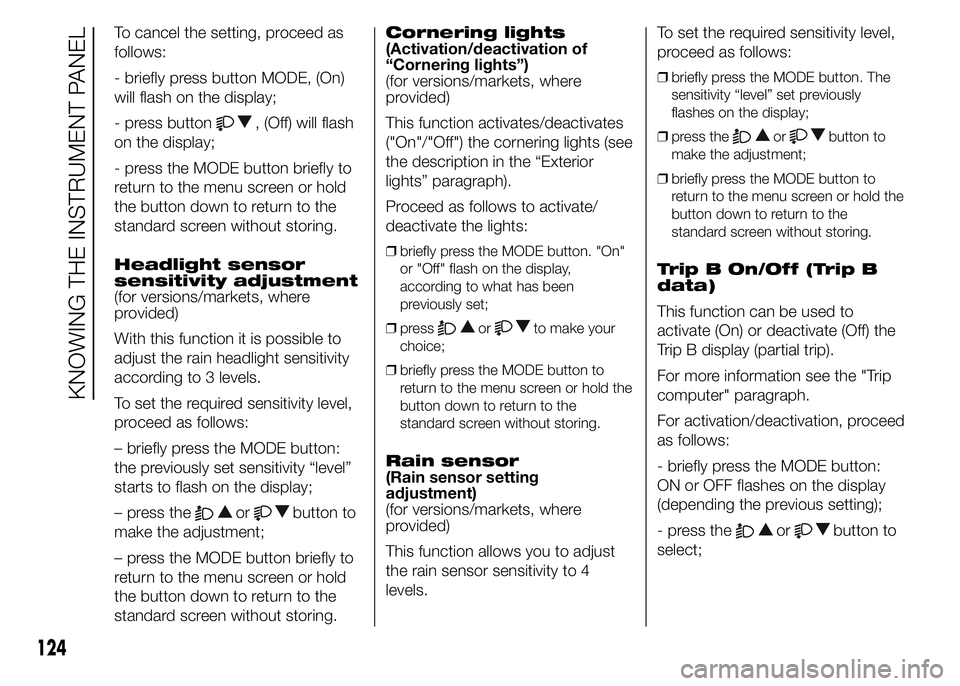
To cancel the setting, proceed as
follows:
- briefly press button MODE, (On)
will flash on the display;
- press button
, (Off) will flash
on the display;
- press the MODE button briefly to
return to the menu screen or hold
the button down to return to the
standard screen without storing.
Headlight sensor
sensitivity adjustment
(for versions/markets, where
provided)
With this function it is possible to
adjust the rain headlight sensitivity
according to 3 levels.
To set the required sensitivity level,
proceed as follows:
– briefly press the MODE button:
the previously set sensitivity “level”
starts to flash on the display;
– press the
orbutton to
make the adjustment;
– press the MODE button briefly to
return to the menu screen or hold
the button down to return to the
standard screen without storing.Cornering lights
(Activation/deactivation of
“Cornering lights”)
(for versions/markets, where
provided)
This function activates/deactivates
("On"/"Off") the cornering lights (see
the description in the “Exterior
lights” paragraph).
Proceed as follows to activate/
deactivate the lights:
❒briefly press the MODE button. "On"
or "Off" flash on the display,
according to what has been
previously set;
❒press
orto make your
choice;
❒briefly press the MODE button to
return to the menu screen or hold the
button down to return to the
standard screen without storing.
Rain sensor
(Rain sensor setting
adjustment)
(for versions/markets, where
provided)
This function allows you to adjust
the rain sensor sensitivity to 4
levels.To set the required sensitivity level,
proceed as follows:
❒briefly press the MODE button. The
sensitivity “level” set previously
flashes on the display;
❒press the
orbutton to
make the adjustment;
❒briefly press the MODE button to
return to the menu screen or hold the
button down to return to the
standard screen without storing.
Trip B On/Off (Trip B
data)
This function can be used to
activate (On) or deactivate (Off) the
Trip B display (partial trip).
For more information see the "Trip
computer" paragraph.
For activation/deactivation, proceed
as follows:
- briefly press the MODE button:
ON or OFF flashes on the display
(depending the previous setting);
- press the
orbutton to
select;
124
KNOWING THE INSTRUMENT PANEL
Page 147 of 367
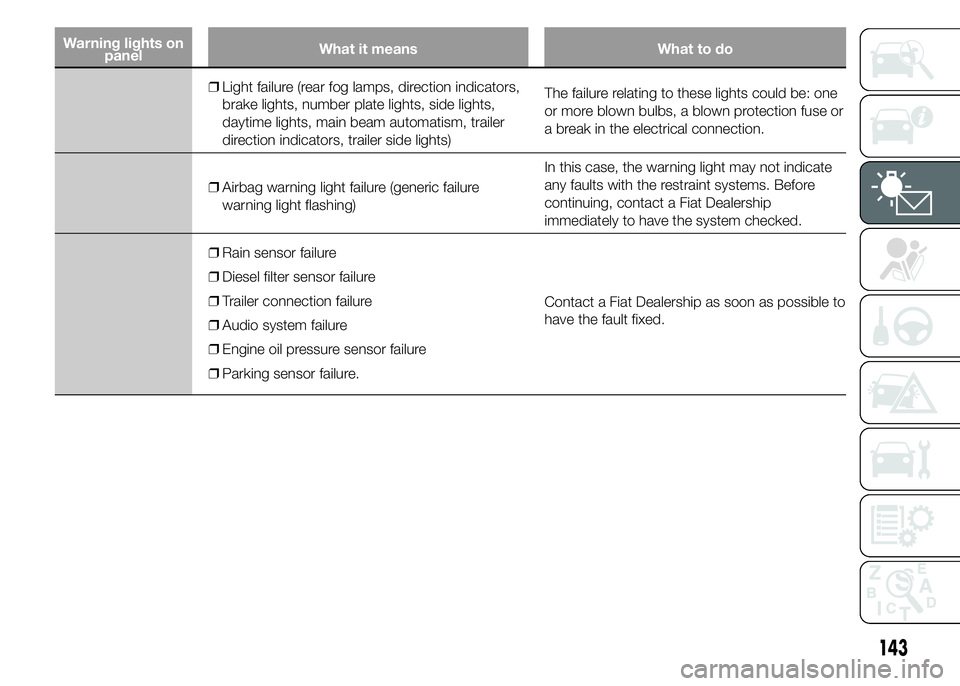
Warning lights on
panelWhat it means What to do
❒Light failure (rear fog lamps, direction indicators,
brake lights, number plate lights, side lights,
daytime lights, main beam automatism, trailer
direction indicators, trailer side lights)The failure relating to these lights could be: one
or more blown bulbs, a blown protection fuse or
a break in the electrical connection.
❒Airbag warning light failure (generic failure
warning light flashing)In this case, the warning light may not indicate
any faults with the restraint systems. Before
continuing, contact a Fiat Dealership
immediately to have the system checked.
❒Rain sensor failure
❒Diesel filter sensor failure
❒Trailer connection failure
❒Audio system failure
❒Engine oil pressure sensor failure
❒Parking sensor failure.Contact a Fiat Dealership as soon as possible to
have the fault fixed.
143
Page 157 of 367
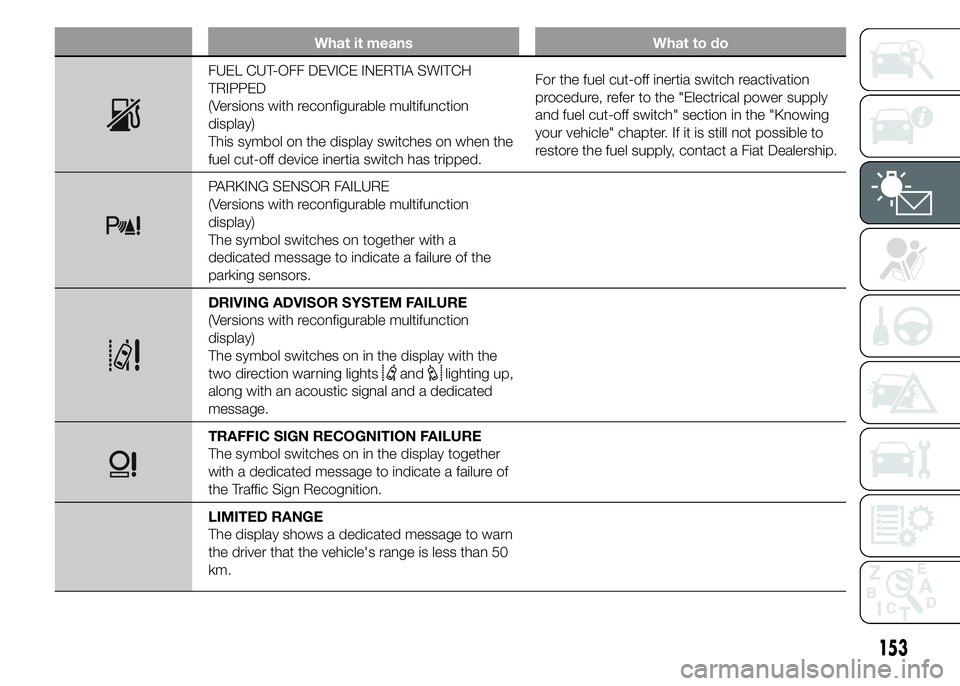
What it means What to do
FUEL CUT-OFF DEVICE INERTIA SWITCH
TRIPPED
(Versions with reconfigurable multifunction
display)
This symbol on the display switches on when the
fuel cut-off device inertia switch has tripped.For the fuel cut-off inertia switch reactivation
procedure, refer to the "Electrical power supply
and fuel cut-off switch" section in the "Knowing
your vehicle" chapter. If it is still not possible to
restore the fuel supply, contact a Fiat Dealership.
PARKING SENSOR FAILURE
(Versions with reconfigurable multifunction
display)
The symbol switches on together with a
dedicated message to indicate a failure of the
parking sensors.
DRIVING ADVISOR SYSTEM FAILURE
(Versions with reconfigurable multifunction
display)
The symbol switches on in the display with the
two direction warning lights
andlighting up,
along with an acoustic signal and a dedicated
message.
TRAFFIC SIGN RECOGNITION FAILURE
The symbol switches on in the display together
with a dedicated message to indicate a failure of
the Traffic Sign Recognition.
LIMITED RANGE
The display shows a dedicated message to warn
the driver that the vehicle's range is less than 50
km.
153
Page 191 of 367
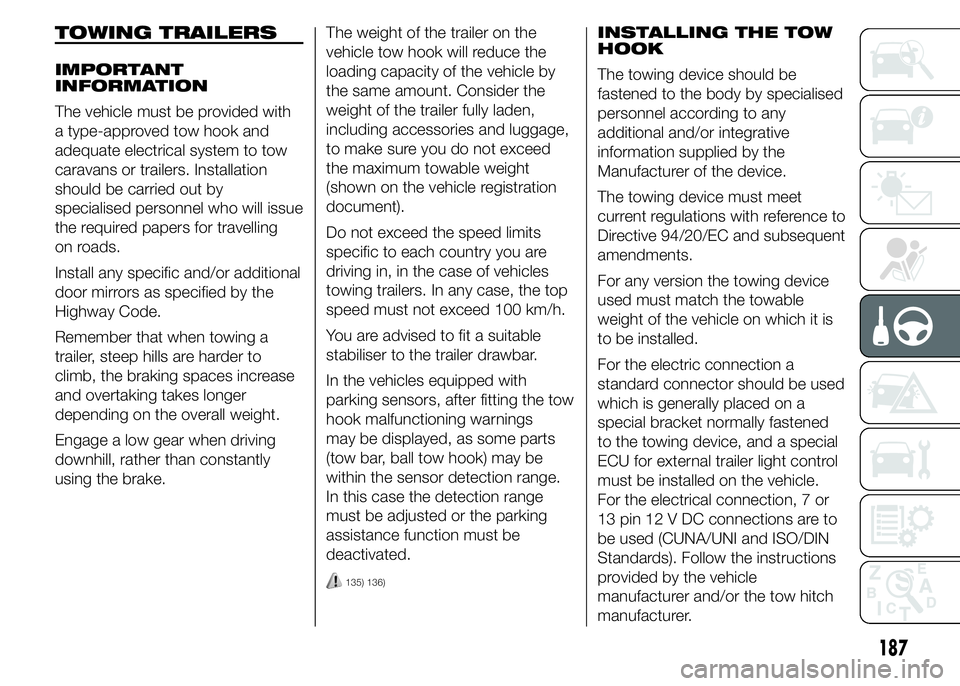
TOWING TRAILERS
IMPORTANT
INFORMATION
The vehicle must be provided with
a type-approved tow hook and
adequate electrical system to tow
caravans or trailers. Installation
should be carried out by
specialised personnel who will issue
the required papers for travelling
on roads.
Install any specific and/or additional
door mirrors as specified by the
Highway Code.
Remember that when towing a
trailer, steep hills are harder to
climb, the braking spaces increase
and overtaking takes longer
depending on the overall weight.
Engage a low gear when driving
downhill, rather than constantly
using the brake.The weight of the trailer on the
vehicle tow hook will reduce the
loading capacity of the vehicle by
the same amount. Consider the
weight of the trailer fully laden,
including accessories and luggage,
to make sure you do not exceed
the maximum towable weight
(shown on the vehicle registration
document).
Do not exceed the speed limits
specific to each country you are
driving in, in the case of vehicles
towing trailers. In any case, the top
speed must not exceed 100 km/h.
You are advised to fit a suitable
stabiliser to the trailer drawbar.
In the vehicles equipped with
parking sensors, after fitting the tow
hook malfunctioning warnings
may be displayed, as some parts
(tow bar, ball tow hook) may be
within the sensor detection range.
In this case the detection range
must be adjusted or the parking
assistance function must be
deactivated.
135) 136)
INSTALLING THE TOW
HOOK
The towing device should be
fastened to the body by specialised
personnel according to any
additional and/or integrative
information supplied by the
Manufacturer of the device.
The towing device must meet
current regulations with reference to
Directive 94/20/EC and subsequent
amendments.
For any version the towing device
used must match the towable
weight of the vehicle on which it is
to be installed.
For the electric connection a
standard connector should be used
which is generally placed on a
special bracket normally fastened
to the towing device, and a special
ECU for external trailer light control
must be installed on the vehicle.
For the electrical connection, 7 or
13 pin 12 V DC connections are to
be used (CUNA/UNI and ISO/DIN
Standards). Follow the instructions
provided by the vehicle
manufacturer and/or the tow hitch
manufacturer.
187
Page 192 of 367
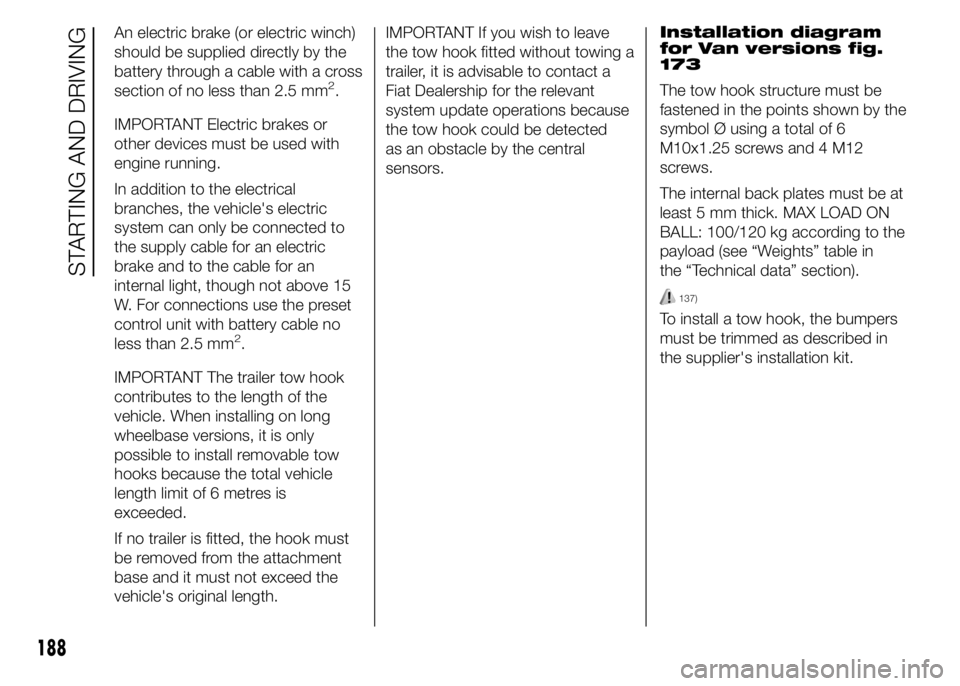
An electric brake (or electric winch)
should be supplied directly by the
battery through a cable with a cross
section of no less than 2.5 mm
2.
IMPORTANT Electric brakes or
other devices must be used with
engine running.
In addition to the electrical
branches, the vehicle's electric
system can only be connected to
the supply cable for an electric
brake and to the cable for an
internal light, though not above 15
W. For connections use the preset
control unit with battery cable no
less than 2.5 mm
2.
IMPORTANT The trailer tow hook
contributes to the length of the
vehicle. When installing on long
wheelbase versions, it is only
possible to install removable tow
hooks because the total vehicle
length limit of 6 metres is
exceeded.
If no trailer is fitted, the hook must
be removed from the attachment
base and it must not exceed the
vehicle's original length.IMPORTANT If you wish to leave
the tow hook fitted without towing a
trailer, it is advisable to contact a
Fiat Dealership for the relevant
system update operations because
the tow hook could be detected
as an obstacle by the central
sensors.Installation diagram
for Van versions fig.
173
The tow hook structure must be
fastened in the points shown by the
symbol Ø using a total of 6
M10x1.25 screws and 4 M12
screws.
The internal back plates must be at
least 5 mm thick. MAX LOAD ON
BALL: 100/120 kg according to the
payload (see “Weights” table in
the “Technical data” section).
137)
To install a tow hook, the bumpers
must be trimmed as described in
the supplier's installation kit.
188
STARTING AND DRIVING
Page 225 of 367

Dashboard fuse box
fig. 226 - fig. 227
DEVICE PROTECTED FUSE AMPERE
Right dipped beam headlight F12 7,5
Left dipped headlight F13 7,5
Engine compartment control unit relay, dashboard control unit relay (+key) F31 5
Lighting of roof lights in the passenger compartment (+battery) F32 7,5
Battery monitoring sensor for Start&Stop versions (+battery) F33 7,5
Minibus interior lights (emergency) F34 7,5
Radio, climate control, alarm, tachograph, battery disconnecting control unit,
Webasto timer (+battery)F36 10
Brake light control (main), third brake light, instrument panel (+key) F37 7,5
Door lock (+battery) F38 20
Windscreen wiper (+key) F43 20
Driver's side electric window F47 20
Passenger side electric window F48 20
Parking sensor control unit, radio, steering wheel controls, central control panel,
left control panel, auxiliary panel, battery disconnecting control unit (+key)F49 5
Climate control, power steering control unit, reverse lights, diesel filter water
sensor, flow meter, tachograph (+key)F51 5
Instrument panel (+battery) F53 7,5
AbsentF89 -
221
Page 229 of 367
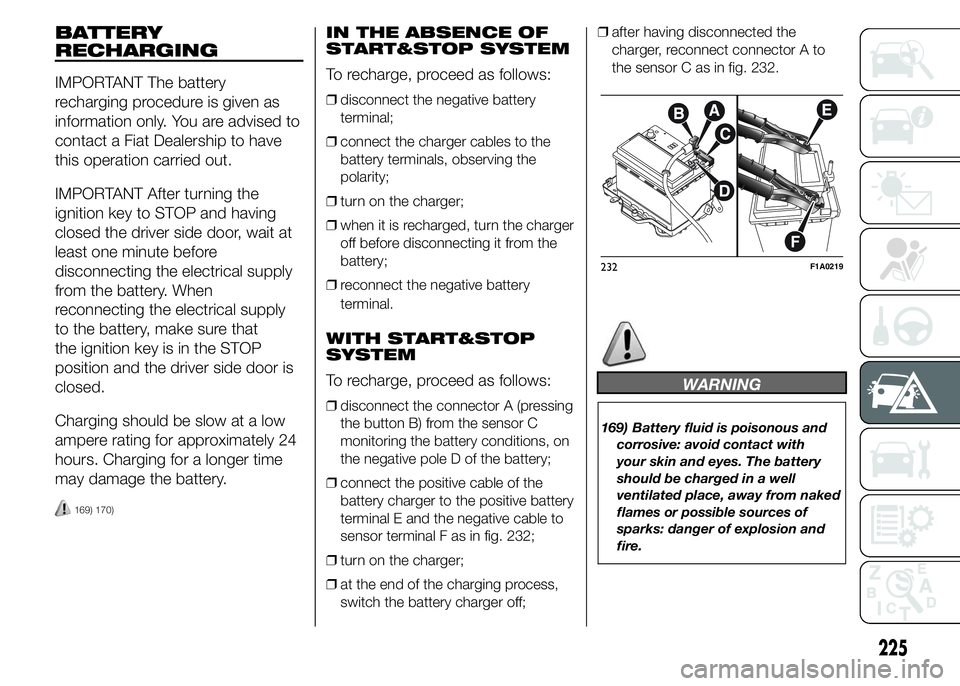
BATTERY
RECHARGING
IMPORTANT The battery
recharging procedure is given as
information only. You are advised to
contact a Fiat Dealership to have
this operation carried out.
IMPORTANT After turning the
ignition key to STOP and having
closed the driver side door, wait at
least one minute before
disconnecting the electrical supply
from the battery. When
reconnecting the electrical supply
to the battery, make sure that
the ignition key is in the STOP
position and the driver side door is
closed.
Charging should be slow at a low
ampere rating for approximately 24
hours. Charging for a longer time
may damage the battery.
169) 170)
IN THE ABSENCE OF
START&STOP SYSTEM
To recharge, proceed as follows:
❒disconnect the negative battery
terminal;
❒connect the charger cables to the
battery terminals, observing the
polarity;
❒turn on the charger;
❒when it is recharged, turn the charger
off before disconnecting it from the
battery;
❒reconnect the negative battery
terminal.
WITH START&STOP
SYSTEM
To recharge, proceed as follows:
❒disconnect the connector A (pressing
the button B) from the sensor C
monitoring the battery conditions, on
the negative pole D of the battery;
❒connect the positive cable of the
battery charger to the positive battery
terminal E and the negative cable to
sensor terminal F as in fig. 232;
❒turn on the charger;
❒at the end of the charging process,
switch the battery charger off;❒after having disconnected the
charger, reconnect connector A to
the sensor C as in fig. 232.
WARNING
169) Battery fluid is poisonous and
corrosive: avoid contact with
your skin and eyes. The battery
should be charged in a well
ventilated place, away from naked
flames or possible sources of
sparks: danger of explosion and
fire.
232F1A0219
225
Page 245 of 367
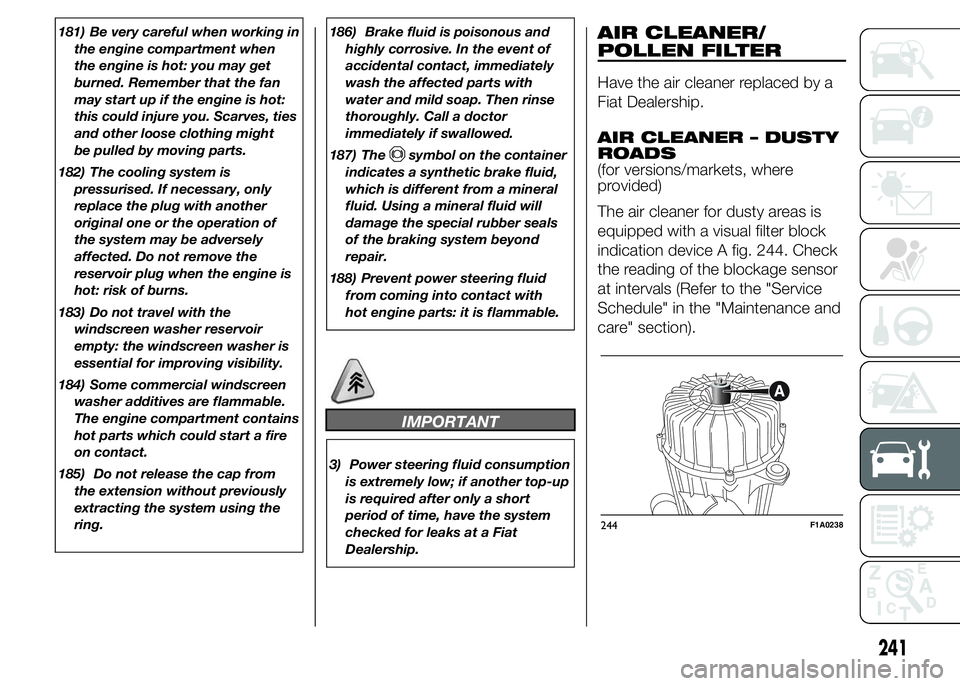
181) Be very careful when working in
the engine compartment when
the engine is hot: you may get
burned. Remember that the fan
may start up if the engine is hot:
this could injure you. Scarves, ties
and other loose clothing might
be pulled by moving parts.
182) The cooling system is
pressurised. If necessary, only
replace the plug with another
original one or the operation of
the system may be adversely
affected. Do not remove the
reservoir plug when the engine is
hot: risk of burns.
183) Do not travel with the
windscreen washer reservoir
empty: the windscreen washer is
essential for improving visibility.
184) Some commercial windscreen
washer additives are flammable.
The engine compartment contains
hot parts which could start a fire
on contact.
185) Do not release the cap from
the extension without previously
extracting the system using the
ring.186) Brake fluid is poisonous and
highly corrosive. In the event of
accidental contact, immediately
wash the affected parts with
water and mild soap. Then rinse
thoroughly. Call a doctor
immediately if swallowed.
187) The
symbol on the container
indicates a synthetic brake fluid,
which is different from a mineral
fluid. Using a mineral fluid will
damage the special rubber seals
of the braking system beyond
repair.
188) Prevent power steering fluid
from coming into contact with
hot engine parts: it is flammable.
IMPORTANT
3) Power steering fluid consumption
is extremely low; if another top-up
is required after only a short
period of time, have the system
checked for leaks at a Fiat
Dealership.
AIR CLEANER/
POLLEN FILTER
Have the air cleaner replaced by a
Fiat Dealership.
AIR CLEANER – DUSTY
ROADS
(for versions/markets, where
provided)
The air cleaner for dusty areas is
equipped with a visual filter block
indication device A fig. 244. Check
the reading of the blockage sensor
at intervals (Refer to the "Service
Schedule" in the "Maintenance and
care" section).
244F1A0238
241
Page 249 of 367
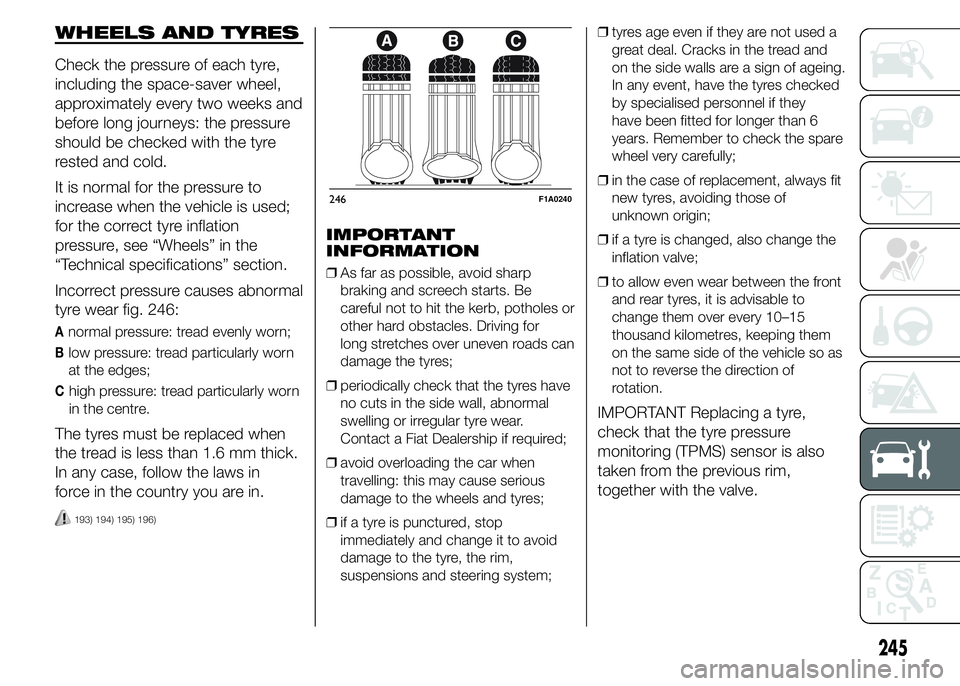
WHEELS AND TYRES
Check the pressure of each tyre,
including the space-saver wheel,
approximately every two weeks and
before long journeys: the pressure
should be checked with the tyre
rested and cold.
It is normal for the pressure to
increase when the vehicle is used;
for the correct tyre inflation
pressure, see “Wheels” in the
“Technical specifications” section.
Incorrect pressure causes abnormal
tyre wear fig. 246:
Anormal pressure: tread evenly worn;
Blow pressure: tread particularly worn
at the edges;
Chigh pressure: tread particularly worn
in the centre.
The tyres must be replaced when
the tread is less than 1.6 mm thick.
In any case, follow the laws in
force in the country you are in.
193) 194) 195) 196)
IMPORTANT
INFORMATION
❒As far as possible, avoid sharp
braking and screech starts. Be
careful not to hit the kerb, potholes or
other hard obstacles. Driving for
long stretches over uneven roads can
damage the tyres;
❒periodically check that the tyres have
no cuts in the side wall, abnormal
swelling or irregular tyre wear.
Contact a Fiat Dealership if required;
❒avoid overloading the car when
travelling: this may cause serious
damage to the wheels and tyres;
❒if a tyre is punctured, stop
immediately and change it to avoid
damage to the tyre, the rim,
suspensions and steering system;❒tyres age even if they are not used a
great deal. Cracks in the tread and
on the side walls are a sign of ageing.
In any event, have the tyres checked
by specialised personnel if they
have been fitted for longer than 6
years. Remember to check the spare
wheel very carefully;
❒in the case of replacement, always fit
new tyres, avoiding those of
unknown origin;
❒if a tyre is changed, also change the
inflation valve;
❒to allow even wear between the front
and rear tyres, it is advisable to
change them over every 10–15
thousand kilometres, keeping them
on the same side of the vehicle so as
not to reverse the direction of
rotation.
IMPORTANT Replacing a tyre,
check that the tyre pressure
monitoring (TPMS) sensor is also
taken from the previous rim,
together with the valve.
246F1A0240
245
Page 362 of 367
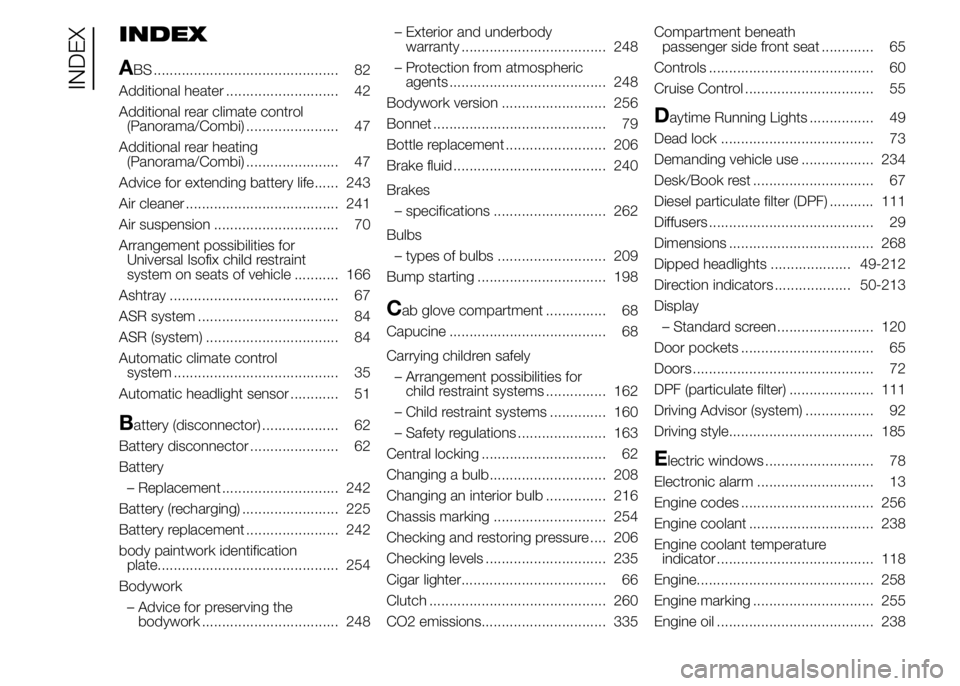
INDEX
A
BS .............................................. 82
Additional heater ............................ 42
Additional rear climate control
(Panorama/Combi) ....................... 47
Additional rear heating
(Panorama/Combi) ....................... 47
Advice for extending battery life...... 243
Air cleaner ...................................... 241
Air suspension ............................... 70
Arrangement possibilities for
Universal Isofix child restraint
system on seats of vehicle ........... 166
Ashtray .......................................... 67
ASR system ................................... 84
ASR (system) ................................. 84
Automatic climate control
system ......................................... 35
Automatic headlight sensor ............ 51
Battery (disconnector) ................... 62
Battery disconnector ...................... 62
Battery
– Replacement ............................. 242
Battery (recharging) ........................ 225
Battery replacement ....................... 242
body paintwork identification
plate............................................. 254
Bodywork
– Advice for preserving the
bodywork .................................. 248– Exterior and underbody
warranty .................................... 248
– Protection from atmospheric
agents ....................................... 248
Bodywork version .......................... 256
Bonnet ........................................... 79
Bottle replacement ......................... 206
Brake fluid ...................................... 240
Brakes
– specifications ............................ 262
Bulbs
– types of bulbs ........................... 209
Bump starting ................................ 198
Cab glove compartment ............... 68
Capucine ....................................... 68
Carrying children safely
– Arrangement possibilities for
child restraint systems ............... 162
– Child restraint systems .............. 160
– Safety regulations ...................... 163
Central locking ............................... 62
Changing a bulb............................. 208
Changing an interior bulb ............... 216
Chassis marking ............................ 254
Checking and restoring pressure .... 206
Checking levels .............................. 235
Cigar lighter.................................... 66
Clutch ............................................ 260
CO2 emissions............................... 335Compartment beneath
passenger side front seat ............. 65
Controls ......................................... 60
Cruise Control ................................ 55
Daytime Running Lights ................ 49
Dead lock ...................................... 73
Demanding vehicle use .................. 234
Desk/Book rest .............................. 67
Diesel particulate filter (DPF) ........... 111
Diffusers ......................................... 29
Dimensions .................................... 268
Dipped headlights .................... 49-212
Direction indicators ................... 50-213
Display
– Standard screen ........................ 120
Door pockets ................................. 65
Doors ............................................. 72
DPF (particulate filter) ..................... 111
Driving Advisor (system) ................. 92
Driving style.................................... 185
Electric windows ........................... 78
Electronic alarm ............................. 13
Engine codes ................................. 256
Engine coolant ............................... 238
Engine coolant temperature
indicator ....................................... 118
Engine............................................ 258
Engine marking .............................. 255
Engine oil ....................................... 238
INDEX